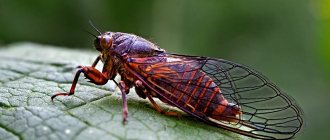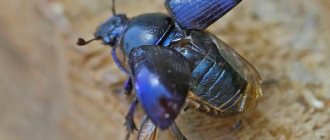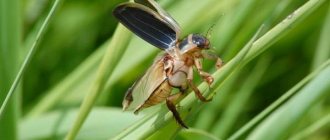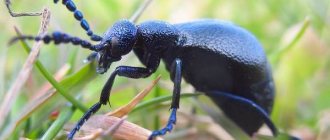The author of the article is a master’s degree in “Plant Quarantine”
Not many people know that gadflies are dangerous insects and parasites on people and animals. Very often people mistake gadflies for horse flies and believe that they only sting. But horseflies and gadflies are two different families of dipterans (flies). The insect gadfly is a parasite on mammals, and the horsefly is a member of the family of blood-sucking flies. Externally they are also different.
Gadfly and horsefly
Description and features
The two-winged insect with short antennae belongs to the Tachi-nidae family. Large hemispheres of eyes with a multi-colored iridescence on a shaggy body up to 17 mm long, transparent wings of the fly make up the external appearance. The species Dermatobia hominis, which is dangerous to humans, lives in Central America. It is capable of attacking and laying its eggs under the skin.
Many have seen these large flies with bright colors in the countryside, in nature or fishing. Externally, the gadfly in the photo is very similar to the two-winged horsefly; they are often confused with each other. Their habitat is the same. The bite of a horsefly is dictated by hunger; it is a blood-sucking insect. The main difference is nutrition. A gadfly, like a horsefly , can bite, but only for the purpose of reproduction.
In some regions the insect is known as spiderweed. Many species of dipterous flies that parasitize large mammals are collectively called gadflies. Common features for insects:
- gadfly dimensions 15-20 mm;
- the mouth is absent or reduced;
- body with villi;
- huge eyes;
- oval body;
- the front legs are shorter than the hind legs;
- almost transparent mesh wings.
The body color is very different. For northern latitudes it is of calmer tones:
- brown;
- dark gray;
- different shades of blue.
In the south and tropics, the insect closely resembles small bumblebees with orange and black stripes. It is believed that the gadfly's flight speed of 120-140 km/h is comparable to that of a dragonfly.
Kinds
The family Nu-podermatidae includes insects in which the larva develops in the nodules under the skin of animals. They parasitize many mammals. Among them:
- Small rodents. Here development takes a little time. The female lays eggs on the fur. The larvae that emerge from them burrow under the skin. There is no migration.
- Large mammals. After laying on the hair, the larvae that emerge from the eggs begin migrating to the back of the animal. Their path of movement goes along the subcutaneous layer, inside the muscles and internal organs. Travel time is from 3 to 9 months.
There are types of gadflies:
- Gasterophilidae – parasites in the stomachs of animals. Flies of medium or large size (9-20 mm). Adults do not need food. They are found in the eastern hemisphere, but equines are common everywhere. The larvae live inside the stomachs of odd-toed ungulates, elephants, and hippopotamuses. The female gadfly lays about 2 thousand eggs on the skin or hair layer near the mouth. Gasterophilus pecorum lays eggs on the grass. The first instar larvae enter the digestive system and live until they grow. They come out naturally (with excrement). Animals infected with parasites develop gastrointestinal pathology.
- Horse (Gasterophilus intestinalis) is one of the common species. Length varies from 13 to 16 mm. The hairs on the body are yellow or brown. The wings are all with dark spots. A noticeable feature is a bright black dot in the radial vein. The insect uses horses and donkeys for its reproduction. In females, the ovipositor is strongly bent under the body. During flight, females lay on the surface of the skin in places where victims can scratch with their teeth. When the larva enters the mouth, it develops for about a month, then passes through the pharynx into the stomach. Their number sometimes reaches hundreds.
- Northern deer (Oedemagena taran-di) - lives off reindeer. Animals travel great distances to winter. There the insects grow, leave the host and move into the ground. With the onset of spring, deer migrate north. Young gadflies must fly many kilometers to again parasitize animals. Natural instinct drives the insects north, they reach the victims and begin to attack defenseless deer. One female can lay up to 650 eggs.
All gadflies are divided according to the type of mouth opening. In Oestridae typicae it is absent or underdeveloped. Representatives of the small Cuterebridae group have a more pronounced proboscis (mouth), without tentacles. Scientists divide the first type into three sections:
- Gastricolae - larvae with two hooks for penetration; there are special tubercles with small spines;
- Cavicolae – two hooks and large spines, the female is viviparous, no ovipositor;
- Cuticolae - there are no hooks, the spines are small, they are almost invisible.
Cattle attack Hypoderma bovis De G. bovine botfly . For horses and donkeys, the equine species has become a threat. Sheep try to escape from the sheep type Oestrus ovis L. Even wild animals have their own varieties:
- American squirrels are attacked by C. emasculator Fitch;
- Elephant intestines are infested with Cobboldia elephantis Brau;
- rhino suffers from Gastrophilus Rhinocerontis Ow.
In the tropics of Central America lives Ver macaque and moyocuil, which can accidentally attack a person. After a gadfly bites and the larva implants, a large tumor, or hardening, with a hole at the top grows. This type affects dogs and livestock.
The photo shows a gadfly larva
Development cycle
After mating, the female chooses a place to lay eggs. Typically these are areas where livestock are grazing or stables or farms. The female lays eggs on food plants or animal fur. Next, the hatched larvae enter the animal’s esophagus and develop there or penetrate the skin. This development cycle goes through the gastric and cutaneous gadfly. The cavitary does not lay eggs, but gives birth to larvae in flight, which end up in the mouth, eyes and nose of animals.
Gadflies are divided into 3 families:
- Gastric flies (Gasterophilidae)
- Subcutaneous gadflies (Hypodermatidae)
- Cavity botflies (Oestridae)
Gastric botflies are characterized by the fact that the female lays eggs on the animal’s fur and on its food plants. After hatching, the larvae of the gadfly enter the animal’s body with food or are embedded under the skin. In the stomach they reach full maturity and are released with feces. The larvae that enter through the skin make holes in it, trying to get to the stomach. Thus causing severe itching and inflammation. The most famous representative of this family is the horse gadfly (Gasterophilus intestinalis).
The subcutaneous botfly is a parasite on cattle. They lay eggs on animal hairs. Having hatched from the eggs, the larvae penetrate the host's body. Under the skin, they make passages in the tissues and cause myiases (chambers under the skin with a hole in which the larvae are located). Having reached the second stage, the larvae emerge through fistulas (holes) to the outside. One of the representatives of this family is the bull gadfly (Hypoderma bovis).
Cavity or nasopharyngeal gadflies are viviparous. Females in flight spray larvae into the nose, eyes of animals or people. The larva of the gadfly parasitizes the mucous membrane of the nose and eyes, on the eyelid and inside the eyeball. They are localized in the nasopharynx, nasal and frontal sinuses. Two prominent representatives of this family are the Russian gadfly (Rhinoestrus purpureus) and the sheep gadfly (Oestrus ovis).
Horse gadfly - Gasterophilus intestinalis
Horse Gadfly
A representative of the gastric gadfly family. It lives everywhere and belongs to synanthropic insects (whose life activity is associated with humans). The body of the gadfly is slightly pubescent and reaches 16 mm in length. The chest and abdomen are yellow-brown in color, the end of the body is black. The head is light, almost white. There are short antennae on the forehead. Females differ from males in that they have a long ovipositor that bends under the body. The horse botfly is an insect that lays eggs on the fur of animals or plants on which they feed. Next, the larvae emerge from the eggs and try to get to the esophagus, through the skin or through the mouth. The horse botfly is often called the hook botfly because its larvae have several rows of hook-shaped spines with which they cling to the mucous tissues of animals. Feeding on the blood of warm-blooded animals and other nutrients, the larvae go through three stages of development. Having reached 2 cm in body length, they come out along with feces. The larvae pupate in feces. After 30-45 days, adult gadflies emerge from the pupae.
Bovine gadfly - Hypoderma bovis
Bull Gadfly
The bovine gadfly belongs to the subcutaneous gadfly family. Lives in Europe, Asia and North Africa. The body reaches 16 mm. The surface of the body is covered with dense hairs. The color is yellowish-gray. There are two horizontal black stripes in the middle of the thoracic segment and abdomen. The female bovine gadfly lays one egg per hair of the animal. Once hatched, the larva burrows into the skin and can migrate through the tissues inside the body, feeding on blood and other nutrients. Having traveled inside the body, the parasite nevertheless returns under the skin of the animal (before molting in the second stage of development). There he creates a kind of chamber with fistulas (holes) through which air enters. After some time, the larvae emerge from the animal skins. They pupate in manure or soil. And after just a few days, adult individuals emerge from the pupae, ready for reproduction. Bull Gadfly
Human gadfly - Dermatobia hominis
Human gadfly
Distributed in South and Central America, in the forests of Argentina and Mexico, but can easily be transported by infected people to other countries. The human gadfly reaches 18 mm in length. The head is yellow with large black eyes. The abdomen is blue with a metallic tint. The body is densely covered with hairs. After fertilization, the female human gadfly lays eggs on blood-sucking parasites: ticks, mosquitoes, etc. During a bite, the larva emerges from the egg and burrows into the skin of a person or animal. The larvae are white, with many black dots and spines on the thoracic segment. Sometimes the larvae can move around inside the body, but mostly they are in the so-called chambers with holes, waiting for the completion of their development. Air enters the chamber through openings (fistulas). The larvae feed on liquid substances of the human body, and decompose solid substances with special dermatolytic enzymes. After some time, the larva leaves the host's body. It pupates in the ground and after 2-3 weeks an adult gadfly emerges. After a few minutes, he is already able to fly and reproduce. Humans may also be susceptible to infiltration by other types of gadflies, such as the sheep, bull, or horse gadflies. In any case, such a parasite causes severe damage and infection of the skin, and in some cases, death.
Gadfly larva in a person
Lifestyle and habitat
The place of parasitism in gadflies is different, therefore there are 3 types:
- Gastric. Distributed almost everywhere. The female lays eggs on wool, limbs or grass. After penetration inside, the maturation cycle begins. The result is access to the surface of the skin through fistulas or with waste products. All this causes severe itching in the animal. The most common is the horse gadfly .
- Subcutaneous. The habitat of this type is all latitudes except the Far North. It chooses cattle as its victims. The female insect lays eggs on the fur, and the larva penetrates the skin. A focus of inflammation – myiasis – develops. Before molting begins, the parasite enters the subcutaneous layer, forming holes there. There have been recorded cases of it penetrating inside the skull of an animal and the human brain. This resulted in death.
Subcutaneous gadfly, lays larvae when bitten
- Cavity. The main difference from the previous ones is that females give birth to larvae during flight, bypassing the stage of laying eggs. They are able to spray them onto the mucous membranes of the eyes, nostrils of an animal or a person. After which the parasite remains inside the eye, eyelid or nose. Then, by migration, it gets inside - the sinuses, the oral cavity, etc. Severe inflammation develops at the injection site.
The gadfly is most often found on sheep
The human gadfly is not found in Russia, but can be spread by people already infected with parasites. It differs from the others in its penetration mechanism. The female first lays eggs on an insect that can feed on human blood. This is usually a mosquito, tick or other bloodsucker. After a bite, the gadfly larva moves under the skin of the victim, where the life process continues.
The parasite can be found everywhere except the coldest latitudes (Antarctica). mainly lives in warm and temperate climates. In Russia there are many of them in the vastness of Siberia, the Ural and Northern regions. Frequent clusters of insects nearby:
- pastures;
- livestock farms;
- places where animals pass.
Insects love a humid climate, so they swarm in large numbers near rivers, ponds and swamps.
Where do gadflies live?
Gadflies do not have nests, so it is impossible to find and destroy any specific place where gadflies live. These parasites are found primarily near farms, subsistence farms, or other livestock areas. They are extremely active in the heat, especially near bodies of water. If, for example, cows graze from time to time near your resting place, it is highly likely that there will be a lot of gadflies in this place. In a global sense, certain types of gadflies are found throughout Russia, with the exception of the subpolar and polar regions.
Despite the fact that gadflies do not drink blood and do not regard humans as their main source of nutrition, they can still be dangerous to people, dogs or cats. In order to avoid any problems associated with them, it is necessary to start getting rid of insects in time.
Nutrition
The parasite larva receives nutrition while inside the victim. Adults cannot absorb food; their oral apparatus is reduced. The pest inside the victim is pear-shaped with the obligatory spines on its scales for advancement. All this is enclosed in a sclerosed capsule, with a hole at the bottom. Length reaches 25 mm, diameter 7 mm.
The basis for nutrition is blood fluid. After securing itself inside the host, the larva begins to accumulate all the useful substances for further existence. The parasite secretes a liquid mass in its body, causing severe pain and inflammation.
Lifespan
Botflies are fully metamorphosed insects that go through the entire development cycle from the egg through the larval, pupa and adult phases. The life cycle lasts a whole year. Moreover, adult individuals do not have the opportunity to feed, but exist thanks to previously accumulated substances in the body in the larval stage.
How long gadflies live depends on the air temperature and how quickly the insect can accommodate its offspring. Females try to choose a suitable place on the victim’s skin, where there is less hair, attaching several eggs to each hair. On average, the lifespan of adults is 3-20 days.
To answer the question of where gadflies come from, it is necessary to consider all phases of insect development.
Life cycle of a gadfly
The life cycle consists of several periods and stages:
- Larvae of the 1st stage - develop inside the laid eggs for several days (the speed of development depends on the temperature), and then begin to penetrate the host’s body. Some gradually penetrate the blood vessels, then move to the spine and reach the adipose tissue along the spinal canal, while others move closer to the esophagus to settle in its mucosa.
- Larvae of the 2nd and 3rd stages migrate further to the back and lower back of the animal, here they form capsules of connective tissue. For subsequent development, they require access to oxygen from the atmosphere, so they make passages directly in the host’s skin, called fistulas. Subsequently, they molt; after the completion of the 3rd stage, the already mature larvae come out through holes and, leaving their capsules, fall to the ground, then pupation begins.
- Pupa is a phase that occurs within 1-7 days after the larvae fall out of the fistulas on the host’s skin; the rate of pupation and development of pupae depends on the temperature and humidity of the environment and lasts 33-44 days.
- The emergence of adult individuals (imagoes) from the pupae occurs in a few seconds, and the emerging fly is already ready for mating and can fly.
Interesting!
Since the life of a gadfly is very short, gadflies do not fall asleep in the fall (this is a common misconception) - adults die. The faces survive the winter period in the body of their owner.
What is the danger to humans and animals?
The gadfly is a biting insect ; the gastric and cavitary type is considered the most dangerous for people. After entering the body, the larva begins to actively feed. It deprives him of vital energy, vitamins, and pathological processes begin. Migration throughout the body and internal organs, right up to the brain, causes health problems. Deaths from infection are common.
When the larva gets inside the victim, myiasis begins (the formation of a parasite). More often this happens in the summer. The infection process occurs in stages:
- a female insect attaches eggs to the scalp of a person (usually the head);
- the parasite begins to come to the surface from body heat;
- penetration under the skin or into organs;
- the formation of fistulas for the breathing of parasites, through which they exit.
There is a certain risk group for a person. This category needs to be careful when walking and interacting with livestock. In an area of increased risk of infection:
- advanced age;
- insufficient hygiene;
- mental illnesses;
- craving for alcohol;
- diabetes type 1 and 2;
- diseases that provoke hematopoietic obstruction;
- frequent stays in the tropics and subtropics.
At the slightest sign of infection, you must contact a medical facility. Bodflies are dangerous for animals, they are annoying, and livestock are defenseless from their attacks. The potential victim becomes very nervous and begins to lose weight from poor nutrition.
This reduces milk yield from livestock. Parasitic larvae take useful substances for themselves. A large number of pests weaken animals, they get sick and lose their sight. Migration completes its destructive action after infection. Nerves are damaged, internal bleeding and paralysis begin.
Control measures
In areas where farm animals are especially bothered by gadflies, the most effective way to combat them is a daily preventive inspection combined with wool cleaning. The identified places of penetration of the larvae are lubricated with ordinary petroleum jelly, which closes the pores and bite sites, thus depriving the larva of oxygen under the skin.
Dead larvae should be carefully removed from under the skin with tweezers to prevent rotting and subsequent infection of the skin.
Advice! Regular nail polish is also a product that can block the air supply to the gadfly larva, use it whenever possible.
At the end of the conversation about the insect gadfly, we invite you to watch an instructive video about the development cycles of the gadfly from the popular TV channel NatGeoWild.
Reproduction and lifespan
An insect goes through a full cycle of transformation: egg, larva, pupa, adult. Life expectancy 1 year. There is one peculiarity: adult gadflies do not receive food. Their existence is possible due to the substances in the body obtained by the larva. The life period completely depends on the temperature and the speed with which the insect creates a “platform” for its offspring.
The female gadfly carefully selects a place on the animal's skin. Areas with less wool are suitable for this. They attach up to 2-3 eggs per hair. This condition lasts from 3 to 20 days. Development phases:
- The larva at the 1st stage grows for several days, then gets inside the victim, thanks to hooks on both sides. The movement goes through the blood vessels, the spinal column and to the fat layer in the direction of the brain canal. The rest is sent to the esophagus and penetrates into the mucous tissues.
- Larvae 2-3 tbsp. move to the back and lumbar region. At the attachment site there are tissue capsules. To develop further, they need oxygen. To receive it, the larvae make special passages through the skin of the animal (fistula). As they develop, they molt and emerge to the surface through ready-made holes in the dermis. After which pupation occurs on the ground.
- The next phase lasts from 1 to 7 days after leaving the animal’s body. The rate of further growth of pupae, depending on humidity and temperature, lasts 33-44 days.
- As a result, the adult fly (imago) emerges within three to five seconds. The insect is ready for new mating and flight.
The short life cycle of a fly (1 year) ends in death; the gadfly does not hibernate in the fall. During the cold winter, the larvae live inside the victim. An adult insect lives very little (3-20 days). By the end of life it loses most of its body weight. In cold weather, the insect almost does not fly. In this case, life is extended by another month.
Adult gadflies are able to reproduce immediately after emerging from the pupa. It is noticed that the mating process takes place in a constant place where they fly every year. After which the females begin to search for an animal to procreate. A large number of eggs each contributes to rapid reproduction. Insects have few enemies, only birds. In southern regions, gadflies mate longer than in northern latitudes.
Gadflies have adapted to live next to many animals. They parasitize small rodents, artiodactyls, the largest rhinoceroses and elephants. Even with a minimal number, due to the high fertility of females, insects multiply quickly in the almost complete absence of enemies.
What to do if you are bitten by a horsefly (paut)?
The bite of this insect is very painful. Moreover, its consequences can be very different:
- increased body temperature;
- itching;
- redness;
- tumor;
- edema;
- enlarged lymph nodes;
- suppuration of the skin and soft tissues;
- headache;
- diarrhea and more etc.
Horse flies drink a lot of blood. About 10 times more than a mosquito. At the same time, they need her to continue procreation. Therefore, only female horseflies bite, but males feed on pollen, plant juices, protozoan secretions, etc.
So what measures should be taken after a bite? We recommend doing the following:
- Immediately apply pressure to the wound. This will reduce the flow of blood and the spread of harmful substances that were “acquired” by the bite.
- Apply something cold. A bottle of water from the refrigerator, ice, a piece of frozen meat, etc.
- Treat the wound with iodine, brilliant green, alcohol, chlorhexidine, hydrogen peroxide or another similar antiseptic. Of course, such means may not be at hand - spider webs are unlikely to bite you in the city near your home. If an encounter with an insect occurred in nature, then you can use a compress from a plantain leaf, onion juice, mashed dandelion leaves, yarrow, mint, etc. for treatment.
- It is a good idea to anoint the skin around the bite with anti-inflammatory ointment, which relieves itching and irritation. Especially if you have sensitive skin or have been bitten by several insects.
- In case of allergic reactions, be sure to take Suprastin, Tavegil, Zodak, etc.
You can treat a horsefly (horsefly) bite at home, using ointments and creams, making compresses, relieving pain and fever with drugs like ibuprofen and nimesulide. But if you experience unpleasant reactions (nausea, fever, migraine, burning sensation, or a very swollen leg, arm or other part of the body) that cause you discomfort, then it is best to seek qualified medical help.
You cannot do without a doctor if an insect has bitten you in the eye or near it - there is a high risk of parasitic infestation and infection. We must not forget that the most severe consequences of insect attacks occur in children. Their immune system is developing, and the permeability of blood vessels is higher than that of an adult. As a result, toxins from the fly’s saliva quickly spread throughout the body, causing severe intoxication. Therefore, even in the absence of any symptoms, the child should be shown to a specialist.
For reference! Horseflies and spider flies are dangerous because they are carriers of dangerous infections. These include tularemia, anthrax, polio, filariasis, etc.











